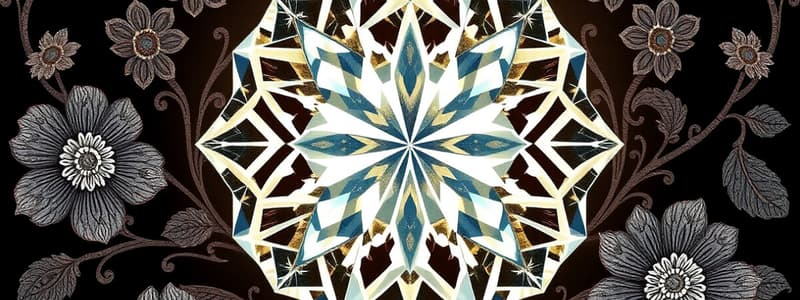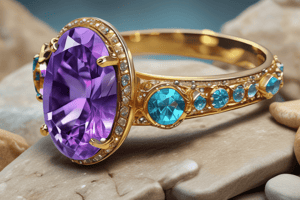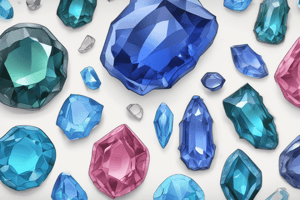Podcast
Questions and Answers
What does a large and dark bow-tie indicate about a diamond's appearance?
What does a large and dark bow-tie indicate about a diamond's appearance?
- It may enhance the diamond's brilliance.
- It significantly affects the diamond's appearance and value. (correct)
- It has no effect on appearance.
- It can be graded as 'slight'.
How do graders assess the pavilion bulge of a diamond?
How do graders assess the pavilion bulge of a diamond?
- By measuring the weight of the stone.
- Without any form of magnification.
- By comparing it to the crown height with the naked eye.
- Using 10x magnification to observe the stone's profile. (correct)
What is the range for a well-proportioned pavilion in relation to crown height?
What is the range for a well-proportioned pavilion in relation to crown height?
- 1.0 to 3.0 times the depth of the crown.
- 2.5 to 4.5 times the depth of the crown. (correct)
- 1.5 to 2.0 times the depth of the crown.
- 4.5 to 6.0 times the depth of the crown.
What is the primary method for calculating the Total Depth Percentage for fancy shapes?
What is the primary method for calculating the Total Depth Percentage for fancy shapes?
When judging culet size in fancy cuts, what is primarily considered?
When judging culet size in fancy cuts, what is primarily considered?
What consequence can pavilion bulge have on a diamond?
What consequence can pavilion bulge have on a diamond?
What aspect of a diamond's appearance do graders assess to determine the bow-tie effect?
What aspect of a diamond's appearance do graders assess to determine the bow-tie effect?
What does symmetry assessment focus on while grading diamonds?
What does symmetry assessment focus on while grading diamonds?
What is a characteristic feature of a baguette diamond?
What is a characteristic feature of a baguette diamond?
What aspect of the diamond grading process involves assessing the angle of the crown?
What aspect of the diamond grading process involves assessing the angle of the crown?
How is the table percentage for fancy shapes calculated?
How is the table percentage for fancy shapes calculated?
What feature does the culet size of a diamond influence?
What feature does the culet size of a diamond influence?
In which type of cut is a trapeze-shaped step cut most commonly classified?
In which type of cut is a trapeze-shaped step cut most commonly classified?
What is primarily assessed by graders when evaluating the bow tie phenomenon in fancy cuts?
What is primarily assessed by graders when evaluating the bow tie phenomenon in fancy cuts?
What is a typical characteristic of large table sizes in fancy cuts?
What is a typical characteristic of large table sizes in fancy cuts?
Which grading aspect is not common to both fancy cuts and round brilliants?
Which grading aspect is not common to both fancy cuts and round brilliants?
What is generally considered when grading the girdle in fancy cuts?
What is generally considered when grading the girdle in fancy cuts?
What commonly attracts people to fancy cuts of diamonds?
What commonly attracts people to fancy cuts of diamonds?
Which term describes the curved area on the side of a pear, marquise, heart, or oval diamond where the width is measured?
Which term describes the curved area on the side of a pear, marquise, heart, or oval diamond where the width is measured?
What is the name of the V-shaped indentation between the lobes of a heart-shaped diamond?
What is the name of the V-shaped indentation between the lobes of a heart-shaped diamond?
What component of the diamond affects its durability when using French tips?
What component of the diamond affects its durability when using French tips?
In diamond grading, what is the name of the area at the bottom of certain fancy cuts where pavilion facets meet?
In diamond grading, what is the name of the area at the bottom of certain fancy cuts where pavilion facets meet?
Which cutting style is characterized by having additional facets placed symmetrically on a brilliant cut diamond?
Which cutting style is characterized by having additional facets placed symmetrically on a brilliant cut diamond?
What do graders typically evaluate for fancy cut diamonds?
What do graders typically evaluate for fancy cut diamonds?
What directly influences the appeal of a fashioned diamond when viewed face-up?
What directly influences the appeal of a fashioned diamond when viewed face-up?
Which feature of fancy cuts does not have a universal standard of beauty, as it is determined mostly by personal taste?
Which feature of fancy cuts does not have a universal standard of beauty, as it is determined mostly by personal taste?
Which component is NOT a special name associated with the shape components of fancy cuts?
Which component is NOT a special name associated with the shape components of fancy cuts?
What is typically assessed in a total depth percentage calculation for fancy cut diamonds?
What is typically assessed in a total depth percentage calculation for fancy cut diamonds?
What characteristic is evaluated to assess the appeal of marquises, pears, and hearts with regards to wing shape?
What characteristic is evaluated to assess the appeal of marquises, pears, and hearts with regards to wing shape?
Which statement about length-to-width ratio is true?
Which statement about length-to-width ratio is true?
What is a potential issue with a culet placement during symmetry evaluation?
What is a potential issue with a culet placement during symmetry evaluation?
What aspect of fancy cuts is evaluated using a 10x loupe?
What aspect of fancy cuts is evaluated using a 10x loupe?
What effect can a substantial bow tie have on a diamond's appearance?
What effect can a substantial bow tie have on a diamond's appearance?
In determining culet size, which option represents a desirable feature in a diamond?
In determining culet size, which option represents a desirable feature in a diamond?
In the context of total depth percentage, what does a lower ratio indicate?
In the context of total depth percentage, what does a lower ratio indicate?
What is a key indicator of depth percentage in diamonds?
What is a key indicator of depth percentage in diamonds?
Which finish grade reflects the highest quality for fancy-cut diamonds?
Which finish grade reflects the highest quality for fancy-cut diamonds?
Why is the culet size important in the assessment of a diamond?
Why is the culet size important in the assessment of a diamond?
What is a significant consideration when grading the appeal of shape in fancy cuts?
What is a significant consideration when grading the appeal of shape in fancy cuts?
What depth percentage range is generally considered ideal for a round brilliant diamond?
What depth percentage range is generally considered ideal for a round brilliant diamond?
What do fancy cut diamond buyers consider most important before making a purchase?
What do fancy cut diamond buyers consider most important before making a purchase?
What can cause a fancy cut diamond's symmetry to be rated poorly?
What can cause a fancy cut diamond's symmetry to be rated poorly?
Flashcards
Total Depth Percentage
Total Depth Percentage
Calculated by dividing the stone's depth by its width and multiplying by 100.
Pavilion Depth
Pavilion Depth
Gem's pavilion depth evaluated visually and compared to crown height.
Bow Tie
Bow Tie
A dark feature (light gray-black) visible on the diamond's face. Darker = more noticeable.
Pavilion Bulge
Pavilion Bulge
Signup and view all the flashcards
Culet Size
Culet Size
Signup and view all the flashcards
Shape Appeal
Shape Appeal
Signup and view all the flashcards
Symmetry
Symmetry
Signup and view all the flashcards
Girdle Thickness
Girdle Thickness
Signup and view all the flashcards
NC
NC
Signup and view all the flashcards
WC
WC
Signup and view all the flashcards
HS
HS
Signup and view all the flashcards
FW
FW
Signup and view all the flashcards
BW
BW
Signup and view all the flashcards
UP
UP
Signup and view all the flashcards
ML
ML
Signup and view all the flashcards
Length-to-Width Ratio
Length-to-Width Ratio
Signup and view all the flashcards
Line Symmetry
Line Symmetry
Signup and view all the flashcards
Why Grade Fancy Cuts
Why Grade Fancy Cuts
Signup and view all the flashcards
Baguette Cut
Baguette Cut
Signup and view all the flashcards
Lozenge Step Cut
Lozenge Step Cut
Signup and view all the flashcards
Trapeze Step Cut
Trapeze Step Cut
Signup and view all the flashcards
Triangular Step Cut
Triangular Step Cut
Signup and view all the flashcards
Asscher Cut
Asscher Cut
Signup and view all the flashcards
Grading of Fancy Cuts
Grading of Fancy Cuts
Signup and view all the flashcards
Clarity of Fancy Cuts
Clarity of Fancy Cuts
Signup and view all the flashcards
Color of Fancy Cuts
Color of Fancy Cuts
Signup and view all the flashcards
Table Percentage in Fancy Cuts
Table Percentage in Fancy Cuts
Signup and view all the flashcards
Crown Angle in Fancy Cuts
Crown Angle in Fancy Cuts
Signup and view all the flashcards
Diamond Shape & Cut Naming
Diamond Shape & Cut Naming
Signup and view all the flashcards
Modified Brilliant Cut
Modified Brilliant Cut
Signup and view all the flashcards
Fancy-Cut Brilliant
Fancy-Cut Brilliant
Signup and view all the flashcards
Princess Cut
Princess Cut
Signup and view all the flashcards
Radiant Cut
Radiant Cut
Signup and view all the flashcards
Fancy Cut Diamonds
Fancy Cut Diamonds
Signup and view all the flashcards
Fancy Cut Grading Criteria
Fancy Cut Grading Criteria
Signup and view all the flashcards
What makes a fancy cut beautiful?
What makes a fancy cut beautiful?
Signup and view all the flashcards
Cutting Style
Cutting Style
Signup and view all the flashcards
Brilliant Cut
Brilliant Cut
Signup and view all the flashcards
Modified Brilliant
Modified Brilliant
Signup and view all the flashcards
Belly of a Fancy Cut
Belly of a Fancy Cut
Signup and view all the flashcards
Wing of a Fancy Cut
Wing of a Fancy Cut
Signup and view all the flashcards
Head of a Pear or Oval
Head of a Pear or Oval
Signup and view all the flashcards
Shoulders of a Pear or Oval
Shoulders of a Pear or Oval
Signup and view all the flashcards
Study Notes
Fancy Cut Diamonds
- Fancy cuts differ from standard round brilliants in shape and cutting styles; they include specific fancy shapes.
- Grading considers color, symmetry, and other characteristics like round brilliants.
- "Cut" refers to both shape and cutting style.
- Brilliant, step, and mixed cuts are the major diamond cutting styles.
- Modified brilliants have additional facets symmetrically placed.
- A diamond's face-up shape is usually the first noticeable feature.
Fancy Cut Components
- Belly: The central curved area of pear, marquise, heart, or oval cuts.
- Wing: The area between the belly and point of pear or oval-shaped cuts.
- Head: The rounded end of pear or oval-shaped cuts.
- Shoulders: The curved edges between head and belly of pear or oval cuts.
- Lobes: Rounded portions in heart-shaped cuts.
- Cleft: The V-shaped indentation between lobes in heart-shaped cuts.
- French Tips: Facet variation in some fancy cuts that replaces large bezel facets.
- Keel Line: The bottom edge where pavilion facets meet in step, modified brilliant, or standard brilliant cuts.
Fancy Cut Descriptions
- GIA uses a standard system for describing diamond shapes and cutting styles (e.g., "Oval Brilliant").
- "Cut-cornered" or "round-cornered" describes beveled or rounded corners.
- "Modified" describes variations in brilliant cuts or other shapes.
- Fancy-shaped brilliants are considered standard brilliants regardless of facet arrangement differences.
Princess and Radiant Cuts
- Princess Cut: A trade term for a square or rectangular modified brilliant, popular in the 1970s. High yield compared to round brilliants. Often used in channel or invisible settings.
- Radiant Cut: Patented in the 1970s by Henry Grossbard; square or rectangular modified brilliant with beveled corners. Retains about 60% of the rough stone.
Pear, Oval, and Marquise Cuts
- Pear (Pendeloque): Elongated, narrow shape.
- Oval: Elliptical girdle outline, similar to round brilliants.
- Marquise (Navette): Elongated, elliptical shape with curved sides and pointed ends. Popular in the 1970s.
Triangular and Heart Cuts
- Triangular (Trillion): Triangular face-up shape. Variations like Trielle and Trilliant.
- Heart: Heart-shaped face-up outline, associated with romance.
- Cushion and Other Cuts: Classic, rectangular or square shape with rounded corners (antique version is called old mine).
- Half-Moon: Face-up outline resembling half a circle.
Antique Cuts
- Brooch: Teardrop shape with triangular facets, no girdle.
- Rose: Flat base, triangular facets, can be round, triangular, or pear-shaped.
- Bead: Rounded and completely faceted, drilled lengthwise (spacial in pearl strands).
- Rondelle: Faceted disk with edges, often used as spacers.
Step Cuts
- Emerald Cut: Common step cut with beveled corners and concentric facets.
- Baguette: Small, four-sided step cut, used as accent stones.
- Lozenge: Four-sided face-up outline with narrow angles
- Trapeze: Four-sided face-up outlines, some sides are parallel, unequally long
- Triangular: Four-sided shape with angled outs.
- Asscher: Square or rectangular step cut.
Grading Fancy Cuts
- Graders consider emotional response to appearance. Important to note that fancy cuts have many variables.
- Clarity: Similar rules to round brilliants, but step cuts are more likely to display inclusions.
- Color: Similar grading process as round brilliants.
- Table, Crown, Girdle: Specific measurements and percentages are calculated for fancy shapes.
- Total Depth: Calculated based on width.
- Pavilion Depth: Relationship between pavilion and crown heights evaluated visually.
- Bow Tie/Bulge: Visibility graded under 10x magnification.
- Culet: Size measured (width prioritized for some fancy cuts).
- Shape Appeal: Symmetry and appearance compared to other diamonds in same shape and cut.
- Length to Width Ratios: Another way to evaluate appearance
- Finish: Evaluation of polish and symmetry.
Important Considerations
- Fancy cut grading is an art.
- Gradation reports offer additional information to buyers
Studying That Suits You
Use AI to generate personalized quizzes and flashcards to suit your learning preferences.




